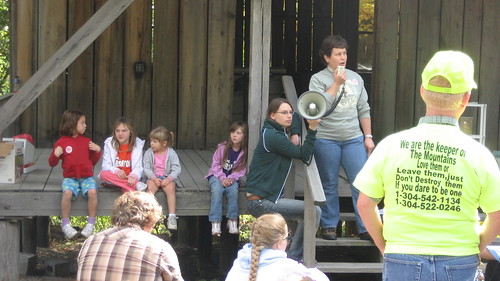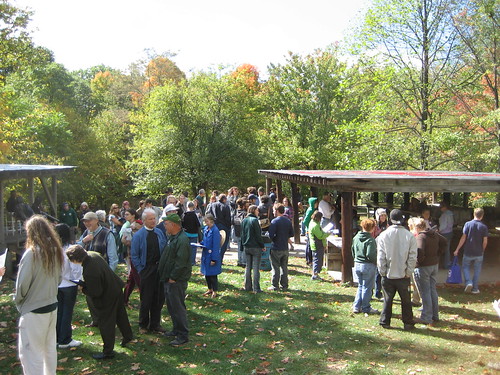Kayford Mountain, WV, News
PRAYER VIGIL HIGHLIGHTS NEED FOR STEWARDSHIP AND PROTECTION OF LAND AND PEOPLE OF WEST VIRGINIA
Saturday, November 17th, 2007
Over 100 gathered to pray for an end to devastation from mountaintop removal mining
CABIN CREEK, W.VA. — Over 100 people of all ages and faiths gathered on Kayford Mountain Saturday (Oct. 20) at a prayer vigil for the mountains and people of Appalachia affected by mountaintop removal mining. Religious leaders representing a range of denominations and backgrounds led prayers and hymns honoring the state’s mountains and asking for the healing of people harmed by surface mining.
The vigil, hosted by the Ohio Valley Environmental Coalition, a West Virginia group fighting mountaintop removal, brought together families, college students and faith-based groups from across the state and region with attendees from as far as Michigan and South Carolina. The gathering came on the heels of last week’s Council of Churches statement condemning mountaintop removal as “unprecedented and permanent.”

“We organized this event to help connect religious communities in the region and hope it will compel people of faith to tell the story of what mountaintop removal is doing to our people,” said Rev. Robin Blakeman, a Presbyterian minister and OVEC volunteer who organized the event.
Throughout the vigil, people directly impacted by this extreme form of mining shared their experiences, including Pauline Canterberry of Sylvester, one of the famed “Sylvester DustBusters.” She explained how coal dust covers the inside of Sylvester residents’ homes, clogging indoor air filters and in some cases causing black lung disease in people who have never entered a mine.
Brenda McCoy of Mingo County held up jars of dark red and black water from people’s homes in her community and explained how their water was poisoned by the underground injection of coal sludge, a waste product from coal preparation plants. People in Mingo County just recently won access to city water from the state after their water was declared toxic. Other communities with similar water issues are also facing unusually high levels of cancer and organ trouble, according to OVEC.
“I think we are looking for a transformation of the heart, to care and weep for God’s creation, and become instruments of healing for the earth and justice for people,” said Allen Johnson, coordinator of Christians for the Mountains, an organization working to rally Christians for solutions to mountaintop removal.

After prayers led by Presbyterian, Unitarian, Episcopal and United Methodist pastors, and testimonies from directly impacted residents from all over southern West Virginia, the group walked to a spot on Kayford Mountain from which they could overlook part of the 12,000 acres of mountaintop removal operations that are consuming the mountain.
“I was blown away that something like this could happen in the United States. It looked like a scar on the land, like a huge bomb had been dropped in the mountains,” said Briana McElfish, a Marshall University student from Putnam County. “We have to look for different ways to get energy. Our country’s coal dependence affects us the most, so we, more than anyone else, should be looking at alternatives. We should be leading the way in renewable energy and efficient technologies, creating jobs and protecting our people.”
“So many children and families are harmed by mountaintop removal in this state. I hope the faith community gets more organized and aware and acts from a deep theological place making this one of the primary moral and ethical concerns for people of faith in our area,” said Blakeman.
In mountaintop removal, coal companies raze forests, then use explosives and giant machines to scalp hundreds of feet off the tops of mountains, in order to get to thin seams of coal. Central Appalachia’s forests are some of the most biologically diverse temperate forests on earth, and studies show mountaintops-removal-mined forests may not recover for centuries.
Hundreds of millions of tons of rubble from the blasted mountaintops is pushed into nearby valleys, burying streams and creating valley fills. In West Virginia, over 1,200 miles of biologically crucial headwaters streams have already been buried or impacted by valley fills.
Concerned citizens say mountaintop removal not only destroys water and forests, but that it also erodes mountain culture. Some people are driven away, and those who do stay see their property devalued and their water wells ruined. The noise and silica-laden dust from blasting at the mine sites adversely impacts people’s health. Studies have shown that valley fills mountaintop removal exacerbates flooding during storm events.
—
Photos by Liz Veazey. See more photos here









